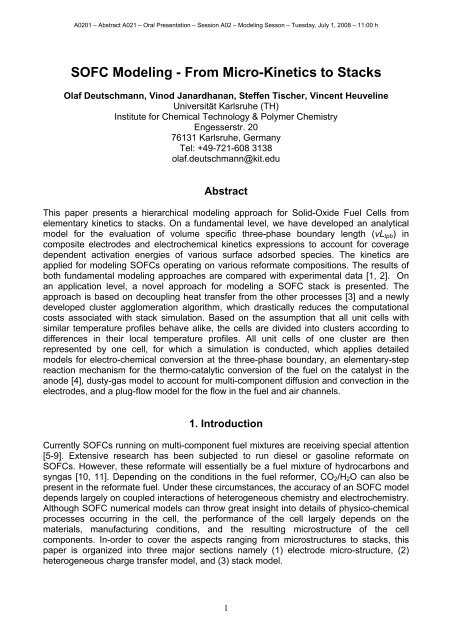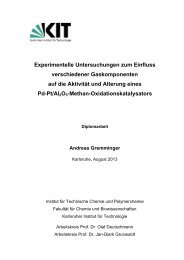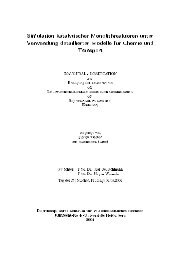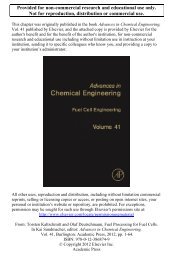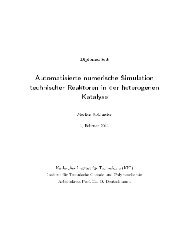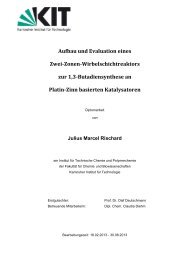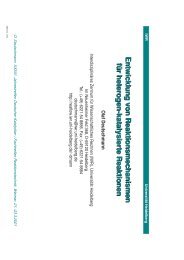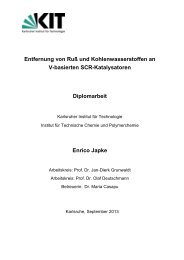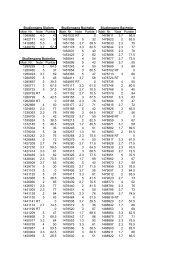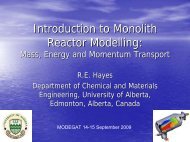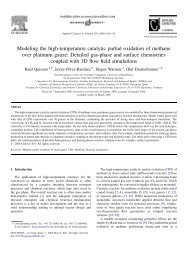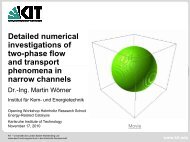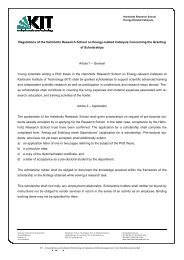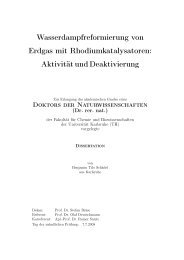SOFC Modeling - From Micro-Kinetics to Stacks - KIT
SOFC Modeling - From Micro-Kinetics to Stacks - KIT
SOFC Modeling - From Micro-Kinetics to Stacks - KIT
Create successful ePaper yourself
Turn your PDF publications into a flip-book with our unique Google optimized e-Paper software.
A0201 – Abstract A021 – Oral Presentation – Session A02 – <strong>Modeling</strong> Sesson – Tuesday, July 1, 2008 – 11:00 h<br />
<strong>SOFC</strong> <strong>Modeling</strong> - <strong>From</strong> <strong>Micro</strong>-<strong>Kinetics</strong> <strong>to</strong> <strong>Stacks</strong><br />
Olaf Deutschmann, Vinod Janardhanan, Steffen Tischer, Vincent Heuveline<br />
Universität Karlsruhe (TH)<br />
Institute for Chemical Technology & Polymer Chemistry<br />
Engesserstr. 20<br />
76131 Karlsruhe, Germany<br />
Tel: +49-721-608 3138<br />
olaf.deutschmann@kit.edu<br />
Abstract<br />
This paper presents a hierarchical modeling approach for Solid-Oxide Fuel Cells from<br />
elementary kinetics <strong>to</strong> stacks. On a fundamental level, we have developed an analytical<br />
model for the evaluation of volume specific three-phase boundary length (vL tpb ) in<br />
composite electrodes and electrochemical kinetics expressions <strong>to</strong> account for coverage<br />
dependent activation energies of various surface adsorbed species. The kinetics are<br />
applied for modeling <strong>SOFC</strong>s operating on various reformate compositions. The results of<br />
both fundamental modeling approaches are compared with experimental data [1, 2]. On<br />
an application level, a novel approach for modeling a <strong>SOFC</strong> stack is presented. The<br />
approach is based on decoupling heat transfer from the other processes [3] and a newly<br />
developed cluster agglomeration algorithm, which drastically reduces the computational<br />
costs associated with stack simulation. Based on the assumption that all unit cells with<br />
similar temperature profiles behave alike, the cells are divided in<strong>to</strong> clusters according <strong>to</strong><br />
differences in their local temperature profiles. All unit cells of one cluster are then<br />
represented by one cell, for which a simulation is conducted, which applies detailed<br />
models for electro-chemical conversion at the three-phase boundary, an elementary-step<br />
reaction mechanism for the thermo-catalytic conversion of the fuel on the catalyst in the<br />
anode [4], dusty-gas model <strong>to</strong> account for multi-component diffusion and convection in the<br />
electrodes, and a plug-flow model for the flow in the fuel and air channels.<br />
1. Introduction<br />
Currently <strong>SOFC</strong>s running on multi-component fuel mixtures are receiving special attention<br />
[5-9]. Extensive research has been subjected <strong>to</strong> run diesel or gasoline reformate on<br />
<strong>SOFC</strong>s. However, these reformate will essentially be a fuel mixture of hydrocarbons and<br />
syngas [10, 11]. Depending on the conditions in the fuel reformer, CO 2 /H 2 O can also be<br />
present in the reformate fuel. Under these circumstances, the accuracy of an <strong>SOFC</strong> model<br />
depends largely on coupled interactions of heterogeneous chemistry and electrochemistry.<br />
Although <strong>SOFC</strong> numerical models can throw great insight in<strong>to</strong> details of physico-chemical<br />
processes occurring in the cell, the performance of the cell largely depends on the<br />
materials, manufacturing conditions, and the resulting microstructure of the cell<br />
components. In-order <strong>to</strong> cover the aspects ranging from microstructures <strong>to</strong> stacks, this<br />
paper is organized in<strong>to</strong> three major sections namely (1) electrode micro-structure, (2)<br />
heterogeneous charge transfer model, and (3) stack model.<br />
1
A0201 – Abstract A021 – Oral Presentation – Session A02 – <strong>Modeling</strong> Sesson – Tuesday, July 1, 2008 – 11:00 h<br />
2. Electrode microstructure<br />
The performance of an <strong>SOFC</strong> largely depends on the microstructure of the resulting<br />
electrodes and the processing conditions. The electrochemical charge transfer reactions<br />
proceeds at the three-phase interfaces (TPB). In a composite electrode, normally the<br />
active TPB region spreads <strong>to</strong> a few microns (10-15 µm) in the vicinity of electrodeelectrolyte<br />
interface. Wilson et al. [1] reported the three-dimensional reconstruction of a<br />
<strong>SOFC</strong> anode using ion-beam scanning electron microscopy <strong>to</strong> determine the microstructural<br />
properties. They estimated the volume-specific TPB length for their sample <strong>to</strong> be<br />
4.28×10 12 m/m 3 . Brown et al. [12] reported that Ni forms larger particles with the particle<br />
sizes ranging from 0.5 <strong>to</strong> 3.0 μm, while YSZ phase particle size distribution were 0.5-1.0<br />
μm. Hence, we need <strong>to</strong> consider the volume specific TPB length for cases with two monosized<br />
particle distributions. Schneider et al. [13] reported the discrete modeling of<br />
composite electrode and developed an analytical model for calculating the TPB length.<br />
The model presented here is developed by considering a geometric volume of a composite<br />
electrode characterized by its porosity and particle radii r 1 and r 2 . We start the model<br />
development by considering the intersection of two spherical particles as shown in Fig 1.<br />
Figure 1: Intersection of two spherical particles.<br />
The volume of the three dimensional lens common <strong>to</strong> both the spheres as a result of<br />
intersection is given by<br />
V<br />
l<br />
2 2 2 2<br />
π ( r1+ r2 − d) ( d + 2dr2 − 3r2 + 2dr1+ 6rr 2 1−3 r1<br />
)<br />
= . (1)<br />
12d<br />
Further the intersection of the spheres is a curve lying in the plane parallel <strong>to</strong> the x-plane<br />
whose radius a is given by<br />
1 2 2 2 2 2 2<br />
a= 4 d r1 −( d − r2 + r1<br />
) . (2)<br />
2d<br />
The <strong>to</strong>tal volume loss V<br />
tl<br />
as a result of intersection is given by<br />
2
A0201 – Abstract A021 – Oral Presentation – Session A02 – <strong>Modeling</strong> Sesson – Tuesday, July 1, 2008 – 11:00 h<br />
V = N (1 − ψ ) V . (3)<br />
tl p l<br />
Here, ψ is the fractional overlap and N<br />
p<br />
is the number of particles. If we assume the<br />
electronic and ionic particles are of different average sizes with radii r 1<br />
and r<br />
2<br />
, then the<br />
ratio between the number of particles M can be defined as<br />
M<br />
N<br />
3<br />
p2<br />
φ2r1<br />
= =<br />
(4)<br />
3<br />
N<br />
p1<br />
φ1r2<br />
with φ 1 and φ 2 as volume fraction of particles with radii r 1 and r 2 , respectively. Let V<br />
t<br />
be the<br />
<strong>to</strong>tal volume of the electrode under consideration then, the <strong>to</strong>tal solid volume V t<br />
can be<br />
expressed as<br />
4 3 4 3<br />
(1 − φ) Vt = Np 1<br />
πr1 + Np2 πr2 − ( Np 1+ Np2)(1 − ψ)<br />
Vl, (5)<br />
3 3<br />
φ is the gas-phase porosity. Combining the above equations, the <strong>to</strong>tal number of particles<br />
can be written as<br />
N<br />
p<br />
=<br />
(1 − φ) Vt<br />
(1 + M)<br />
4 (<br />
3 3<br />
π r1 + Mr2<br />
) − (1 − ψ )(1 + M ) Vl<br />
3<br />
. (6)<br />
The length of boundary due <strong>to</strong> the intersection of two spheres is given by the<br />
circumference of a circle. This becomes a three-phase boundary length (TPB) only if the<br />
intersecting particles are of different phases and the intersection is associated with a pore<br />
space. Therefore, the average TPB length of the composite electrode is given by<br />
L = N min Z , Z φ2π<br />
a, (7)<br />
tpb p i−e e−i<br />
Zi − eis the coordination number between the ionic and electronic conduc<strong>to</strong>rs and Ze − iis the<br />
coordination number between the electronic and ionic conduc<strong>to</strong>rs. The average number of<br />
contacts between the ionic and electronic conducting particle is given by<br />
Z<br />
Z Z<br />
Z<br />
= i e<br />
i− e<br />
φ , (8)<br />
e<br />
and the average number of contacts between the electronic and ionic conducting particle<br />
is given by<br />
ZiZe<br />
Z = e− i<br />
φi<br />
Z<br />
. (9)<br />
Here, Z is the average co-ordination number. Expressions for Z<br />
i<br />
and Ze<br />
are given in [14].<br />
Combination of Eqs. (6) and (7) leads <strong>to</strong> the volume specific three-phase boundary length<br />
vL :<br />
tpb<br />
3
A0201 – Abstract A021 – Oral Presentation – Session A02 – <strong>Modeling</strong> Sesson – Tuesday, July 1, 2008 – 11:00 h<br />
vL<br />
tpb<br />
φ(1 − φ)(1 + M ) min Zi−e, Ze−i<br />
2πa<br />
=<br />
. (10)<br />
4 (<br />
3 3<br />
π r1 + Mr2<br />
) − (1 − ψ )(1 + M ) Vl<br />
3<br />
In the case of mono-sized particles<br />
vLtpb<br />
is given by<br />
vL<br />
tpb<br />
φ(1 −φ) min Zi−e, Ze−i<br />
2πa<br />
=<br />
. (11)<br />
4 3<br />
πr<br />
−(1 −ψ)<br />
Vl<br />
3<br />
The model presented here is developed by considering a geometric volume of a composite<br />
electrode characterized by its porosity φ and particle radii r 1 and r 2 . It is assumed that the<br />
ionic and electronic solid phases are made up of spherical particles.<br />
3. Heterogeneous charge transfer model<br />
Most <strong>SOFC</strong> modeling efforts employ Nernst equation <strong>to</strong> calculate the open circuit potential<br />
and Butler-Volmer equation <strong>to</strong> express the rate of charge transfer reaction. However,<br />
Butler-Volmer equation does not throw any insight in<strong>to</strong> the actual process occurring on the<br />
surface which leads <strong>to</strong> electron transfer near the TPB. Here we present an<br />
electrochemistry model based on heterogeneous chemistry occurring at the TPB. A<br />
detailed version of the following discussions will be published elsewhere [15].<br />
The forward and reverse rate constants for charge transfer reaction are written as<br />
α<br />
0 aF<br />
kfi<br />
= kfi<br />
exp( z Δ φ)<br />
and (12)<br />
RT<br />
α<br />
0 cF<br />
kri<br />
= kri<br />
exp( −z Δ φ)<br />
, (13)<br />
RT<br />
respectively. Here Δ φ is the potential between Ni and YSZ phases. k 0 fi<br />
and k 0 ri<br />
are the<br />
forward and backward thermal rate coefficients, which can be expressed in terms of<br />
modified Arrhenius expression as<br />
k<br />
0<br />
fi<br />
K<br />
E s<br />
βi fi ε<br />
kθk<br />
= AfiT<br />
exp( − ) ∏ exp( − )<br />
(14)<br />
RT RT<br />
k = 1<br />
k<br />
0<br />
ri<br />
K s<br />
βi Eri ε<br />
kθk<br />
= AriT<br />
exp( − ) ∏ exp( − )<br />
(15)<br />
RT RT<br />
k = 1<br />
Here θ<br />
k<br />
is the surface coverage of the k -th species and ε k<br />
is a parameter modelling<br />
coverage dependency of activation energy. All other parameters have the usual meaning.<br />
The faradic current for the i -th charge transfer reaction can then be given as<br />
4
A0201 – Abstract A021 – Oral Presentation – Session A02 – <strong>Modeling</strong> Sesson – Tuesday, July 1, 2008 – 11:00 h<br />
i zFL<br />
⎡<br />
k k<br />
⎣<br />
Ks<br />
K<br />
υ<br />
s<br />
'<br />
υ''<br />
i<br />
=<br />
tpb ⎢ fi<br />
θk −<br />
ri<br />
θk<br />
k= 1 k=<br />
1<br />
⎤<br />
⎥<br />
⎦<br />
∏ ∏ (16)<br />
Here Ltpb<br />
is the area specific TPB length, Ks<br />
is the <strong>to</strong>tal number of surface species and υ '<br />
and υ '' are the s<strong>to</strong>ichiometric coefficients of the reactants and products, respectively.<br />
Based on the above equation the <strong>to</strong>tal Faradic current is written as<br />
N ct<br />
i = ∑ i , (17)<br />
i<br />
i=<br />
1<br />
N<br />
ct<br />
is the <strong>to</strong>tal number of charge transfer reactions. Based on the potential difference<br />
between the electronic and ionic phases, the operating cell potential can be expressed as<br />
Ecell = Δφc −Δφa − ηohm<br />
(18)<br />
Δφ c<br />
and Δφa<br />
are respectively the potential difference on the cathode and anode side.<br />
The following electrochemical reactions are considered for evaluating the model with<br />
experimental measurements:<br />
−<br />
−<br />
2H[Ni] + O[YSZ]<br />
↔ H2O[YSZ]<br />
+ 2[Ni] + 2e<br />
(19)<br />
−<br />
−<br />
CO[Ni] + O[YSZ]<br />
↔ CO2[YSZ]<br />
+ [Ni] + 2e<br />
(20)<br />
x 1<br />
• • −<br />
O [el] ↔ O2<br />
+ Vo<br />
+ 2e .<br />
2<br />
(21)<br />
4. Stack model<br />
The timescales of various processes such as kinetics, diffusion, and heat transfer<br />
occurring in an <strong>SOFC</strong> stack are different from each other, and the heat transfer process<br />
has a larger time constant compared <strong>to</strong> the rest of the processes. In the method adopted<br />
here, the solid-phase temperature is decoupled from the fluid phase <strong>to</strong> develop the<br />
transient stack model, which solves the transient two or three-dimensional heat conduction<br />
problem. While solving the heat conduction equation, the stack is assumed as a porous<br />
media, consisting of straight channels. The heat balance can then be written as<br />
ρC<br />
p<br />
∂T<br />
∂ ⎛ ∂T<br />
= λij<br />
⎞<br />
+ q<br />
∂t ∂x ⎜<br />
i<br />
x ⎟<br />
⎝ ∂<br />
j ⎠<br />
(22)<br />
Here, t = time, T = temperature, ρ = density, C p = heat capacity, λ ij = tensor of heat<br />
conductivity; q is the heat source term arising from the interaction with the individual cells.<br />
The heat source term is derived from the simulation of individual cells. If the cell density is<br />
σ (cells per unit area of the cross-section), the source term can be expressed as<br />
∂H<br />
cell<br />
q = −σ + Qohm<br />
(23)<br />
∂x<br />
H cell is the enthalpy flux in the cell and Q ohm is the heat release due <strong>to</strong> ohmic heating. The<br />
cell model is used for simulations as reported in [4]. A cluster agglomeration algorithm is<br />
5
A0201 – Abstract A021 – Oral Presentation – Session A02 – <strong>Modeling</strong> Sesson – Tuesday, July 1, 2008 – 11:00 h<br />
applied <strong>to</strong> choose the representative cells from the individual cells following the strategy<br />
developed before for transient simulations of catalytic monoliths [18, 19]. More details of<br />
the stack model will be published elsewhere [20].<br />
5.1 Electrode microstructure<br />
5. Results and Discussion<br />
The following results are presented for mono sized particles for both ionic as well as for<br />
electronic phases. Quite obviously Eq. (11) predicts maximum volume specific TPB length<br />
( vL<br />
tpb<br />
) at 50% porosity while other parameters are fixed. Figure 2 displays the influence of<br />
grain size on vLtpb<br />
as a function of gas-phase porosityφ . As predicted by Eq.17, maximum<br />
vLtpb<br />
is observed at 50% porosity for all the grain sizes considered and the vLtpb<br />
increases<br />
with decreasing grain size. For the results presented in Fig. 2, the average distance<br />
between the particles is assumed <strong>to</strong> be 1 μm and a coordination number ( Zi−e= Ze−i) of 7.2<br />
is used. <strong>From</strong> the order of magnitude the results are in good agreement with the<br />
experimental evaluation of vLtpb<br />
by Wolson et al. [1]. More discussions on the application of<br />
the vLtpb<br />
model are published elsewhere [14].<br />
Figure 2: TPB length as a function of porosity for various grain sizes.<br />
5. 2 Heterogeneous charge transfer model<br />
A heterogeneous reaction mechanism consisting of 42 reactions among 6 gas-phase<br />
species and 12 surface adsorbed species used throughout this work and is reported in<br />
[16]. The pure H 2 operated cell is first modeled by fitting the pre-exponential fac<strong>to</strong>r and<br />
coverage dependent activation energy. The fit parameters for the electrochemistry model<br />
are given in Table.1<br />
Table 1: Parameters for electrochemistry model<br />
6
A0201 – Abstract A021 – Oral Presentation – Session A02 – <strong>Modeling</strong> Sesson – Tuesday, July 1, 2008 – 11:00 h<br />
H 2 Oxidation<br />
Activation energy (kJ/mol) 89.4<br />
Pre exponential fac<strong>to</strong>r (mol/cm-s) 8.5x10 -2<br />
Coverage dependent activation energy for H (kJ/mol) -10.0<br />
Coverage dependent activation energy for H2O (kJ/mol) -30.0<br />
CO Oxidation<br />
Activation Energy(kJ/mol) 60.0<br />
Pre exponential (mol/ cm-s) 4.00x10 -4<br />
Coverage dependent activation energy for CO(kJ/mol) -10.0<br />
Order dependency on CO 2 coverage 4<br />
O 2 Reduction<br />
Activation energy (kJ/mol) 120.0<br />
Pre exponential (mol/cm-s) 1.5x10 -2<br />
Comparison between the simulated curve and the experimentally observed one for pure<br />
H 2 operated cell is shown in Fig. 3. The model predicts higher peak power density<br />
compared <strong>to</strong> the experimental observation. Experimentally peak power density of 1.61<br />
W/cm 2 is observed at 3.22 A/ cm 2 , while, the simulation yield 1.81 W/ cm 2 at 3.46 A/ cm 2 .<br />
Although it is quite possible <strong>to</strong> reproduce the same experimental observation<br />
quantitatively, we did not resort <strong>to</strong> that since the fitted parameters adversely affected the<br />
model prediction on the performance on reformate fuel compositions.<br />
Figure 3: Comparison of model prediction with cell performance on pure H2.<br />
Figures 4(a) and 4(b), display the experimentally observed and simulated performance<br />
curves, respectively, for a cell operated with the reformate fuel resulting from the partial<br />
oxidation of methane using air. The details of fuel composition are given in [2].<br />
Experimentally CH4:air ratio of 60:20 gave the best performance with a limiting current of<br />
~4.0 A/cm 2 . The simulations lead <strong>to</strong> a limiting current of ~3.25 A/ cm 2 for the same fuel<br />
composition. For CH4:air ratio of 40:100 the simulations predicted a limiting current of<br />
~2.08 A/ cm 2 , while the experimentally observed value is ~2.5 A/cm 2 . In general the<br />
limiting currents are slightly under predicted by the simulations, and the peak power<br />
densities are predicted within a relative error of ~14%.<br />
7
A0201 – Abstract A021 – Oral Presentation – Session A02 – <strong>Modeling</strong> Sesson – Tuesday, July 1, 2008 – 11:00 h<br />
Figure 4(a): Experimentally measured cell performance with H2 and reformer fuel from the<br />
POM with air diluted with 3% H 2 O (Reproduced from [2]).<br />
Figure 4(b): Simulated cell performance with reformer fuel from the POM with air diluted<br />
with 3% H 2 O.<br />
5.3 Stack model<br />
For demonstration purposes, we consider a stack having active area of 10 cm ×10 cm,<br />
and consisting of 30 cells in co-flow configuration. The anode, cathode, and electrolyte<br />
components are assumed <strong>to</strong> be 750 μ m, 30μ m, and 15μ m thick, respectively. The fuel<br />
and air channels are assumed <strong>to</strong> be of 1 mm 2 cross sectional area. The inlet fuel<br />
composition considered is 31.81% H 2 , 13.19% CO, 13.19% CH 4 , 2.23% CO 2 , 3% H 2 O,<br />
and 36.58% N 2 . Inlet fuel and air are assumed <strong>to</strong> be at 800 °C and 750 °C, respectively.<br />
The exchange current density formulations are taken from [17]. However, the exchange<br />
current density parameters are adjusted <strong>to</strong> produce ~0.72 V at 300 mA/cm 2 . Adiabatic<br />
boundary conditions are implemented for the calculation.<br />
The temperature distribution in the stack at different planes along and across the flow<br />
direction after the first steady state is displayed in Fig. 5. As expected the temperature in<br />
8
A0201 – Abstract A021 – Oral Presentation – Session A02 – <strong>Modeling</strong> Sesson – Tuesday, July 1, 2008 – 11:00 h<br />
the stack increases along the flow direction due <strong>to</strong> the exothermic cell reactions. However,<br />
uniform profiles are observed across the direction of flow. It should be noticed that the<br />
model has the limitation that it does not account for the individual mechanical components<br />
in the stack. It is a lumped parameter model as far as the individual mechanical<br />
components are concerned and therefore, uniform thermal properties are assumed<br />
everywhere in the stack.<br />
Figure 5: Temperature distribution in the 3D stack (solid phase) at different surface planes<br />
along and across the flow direction (average current density = 300 mA/cm 2 )<br />
6. Conclusions<br />
We have developed an analytical expression for the evaluation of volume specific threephase<br />
boundary length in <strong>SOFC</strong> electrodes. The model predictions are in good agreement<br />
with experimental observations. Furthermore, the model is also applicable <strong>to</strong> cases where<br />
the constituent particles are of different size distribution.<br />
The electrochemical model presented takes in<strong>to</strong> account multiple charge transfer reactions<br />
and coverage dependant activation energy for various surface adsorbed species taking<br />
part in the charge transfer reaction. The model predictions are in reasonable agreement<br />
with experimental observations.<br />
The stack model presented here is based on a cluster agglomeration algorithm in choosing<br />
the representative cells for detailed calculation. The approach considerably reduces the<br />
calculation time.<br />
9
A0201 – Abstract A021 – Oral Presentation – Session A02 – <strong>Modeling</strong> Sesson – Tuesday, July 1, 2008 – 11:00 h<br />
References<br />
(1) J. R.Wilson, W. Kobsiriphat, R. Mendoza, H.Y. Chen, J. M.Hiller, D.J. Miller, K. Thorn<strong>to</strong>n, P.W.<br />
Voorhees, S. B. Adler, S. A. Barnett. Nature Materials, 5 (2006) 541-544<br />
(2) B. Tu, Y. Dong, M. Cheng, Z. Tian, Q. Xin. Natural Gas Conversion VIII, Studies in Surface<br />
Science and Catalysis 167, M. Schmal, F.B. Noronha, E. F. Sousa-Aguiar (eds.), p. 43-48,<br />
Elsevier, 2007<br />
(3) E. Achenbach. J. Power Sources 57 (1995) 105-109<br />
(4) H. Zhu, R.J. Kee, V.M. Janardhanan, O. Deutschmann, D.G. Goodwin. J. Electrochem. Soc.<br />
152 (2005) A2427-A2440<br />
(5) E. P. Murray, T. Tsai, S. A. Barnett. Nature 400 (1999) 649<br />
(6) Z. Cheng, S. Zha, L. Aguilar, D. Wand. Electrochem. Solid State Lett. 9 (2006) A31<br />
(7) Y. Lin, Z. Zhan, J. Liu, S.A. Barnett. Solid State Ionics 176 (2005) 1827<br />
(8) J. Liu, S.A. Barnett. Solid State Ionics 158 (2003) 11<br />
(9) B.C.H. Steele. Nature 400 (1999) 619<br />
(10) I. Kang, J. Bae, G. Bae. J. Power Sources 163, (2006) 538<br />
(11) T. Aicher, L. Griesser. J. Power Sources 165 (2007) 210<br />
(12) M. Brown, S. Primdahl, M. Mogensen. J. Electrochem. Soc.,147 (2000) 475<br />
(13) L. Schneider, C. Martin, Y. Bultel, D. Bouvard, E. Siebert. Electrochimica Acta 52 (2006) 314<br />
(14) V. M. Janardhanan, V. Heuveline, O. Deutschmann, J. Power Sources 178 (2008) 368-372<br />
(15) V. M. Janardhanan, S. Tischer, V. Heuveline, B. Tu, M. Cheng, O. Deutschmann, J.<br />
Electrochem. Soc. (submitted)<br />
(16) V. M. Janardhanan, O. Deutschmann. Zeitschrift f. Phys. Chem. 221 (2007) 443<br />
(17) V. M. Janardhanan, O. Deutschmann J. Power Sources 162 (2006) 1192–1202<br />
(18) S. Tischer, O. Deutschmann. Catalysis Today 105 (2005) 407-413<br />
(19) O.Deutschmann, S. Tischer, S. Kleditzsch, V.M. Janardhanan, C. Correa, D. Chatterjee, N.<br />
Mladenov, H. D. Mihn, DETCHEM Software package, 2.1 ed., www.detchem.com, Karlsruhe 2007.<br />
(20) V. M. Janardhanan, S. Tischer, V. Heuveline, O. Deutschmann, J. Power Sources (<strong>to</strong> be<br />
submitted)<br />
10


